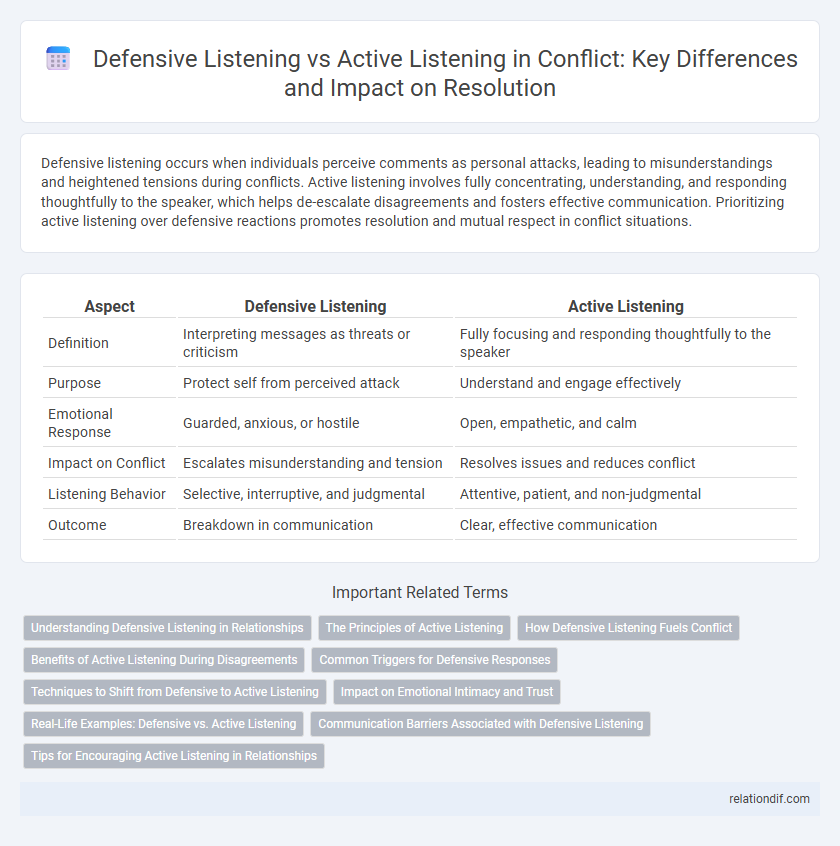Defensive listening occurs when individuals perceive comments as personal attacks, leading to misunderstandings and heightened tensions during conflicts. Active listening involves fully concentrating, understanding, and responding thoughtfully to the speaker, which helps de-escalate disagreements and fosters effective communication. Prioritizing active listening over defensive reactions promotes resolution and mutual respect in conflict situations.
Table of Comparison
| Aspect | Defensive Listening | Active Listening |
|---|---|---|
| Definition | Interpreting messages as threats or criticism | Fully focusing and responding thoughtfully to the speaker |
| Purpose | Protect self from perceived attack | Understand and engage effectively |
| Emotional Response | Guarded, anxious, or hostile | Open, empathetic, and calm |
| Impact on Conflict | Escalates misunderstanding and tension | Resolves issues and reduces conflict |
| Listening Behavior | Selective, interruptive, and judgmental | Attentive, patient, and non-judgmental |
| Outcome | Breakdown in communication | Clear, effective communication |
Understanding Defensive Listening in Relationships
Defensive listening in relationships occurs when individuals perceive messages as personal attacks, leading to misunderstandings and escalating conflict. This behavior often stems from insecurity or past negative experiences, causing partners to respond with hostility or withdrawal instead of open communication. Recognizing and addressing defensive listening is crucial for fostering empathy, improving emotional connection, and promoting healthier interpersonal dynamics.
The Principles of Active Listening
Active listening emphasizes fully concentrating, understanding, responding, and remembering what is being said, which reduces misunderstandings in conflict resolution. Core principles include paying undivided attention, withholding judgment, reflecting content and emotions, and providing appropriate feedback. These practices foster empathy, clarify intentions, and promote collaborative solutions, unlike defensive listening that triggers reactive behavior and escalates conflicts.
How Defensive Listening Fuels Conflict
Defensive listening intensifies conflict by causing misinterpretation of messages as personal attacks, leading to heightened emotional responses and resistance to communication. This type of listening hinders effective dialogue because individuals focus on protecting themselves rather than understanding the speaker's intent, which escalates misunderstandings and tension. In contrast, active listening promotes conflict resolution by fostering empathy and clarifying meanings, reducing the likelihood of defensive reactions.
Benefits of Active Listening During Disagreements
Active listening during disagreements enhances mutual understanding by accurately interpreting the speaker's message and emotions, reducing miscommunication and defensiveness. It fosters empathy and trust, which are critical for resolving conflicts constructively and maintaining positive relationships. This approach ultimately facilitates collaborative problem-solving and decreases the escalation of tensions.
Common Triggers for Defensive Responses
Common triggers for defensive listening include perceived criticism, vague or ambiguous language, and the tone of voice used by the speaker. When individuals interpret messages as personal attacks or threats, they respond by shutting down or counterattacking instead of engaging constructively. Recognizing these triggers enhances conflict resolution by encouraging active listening techniques that promote understanding and reduce defensive reactions.
Techniques to Shift from Defensive to Active Listening
Techniques to shift from defensive to active listening include maintaining open body language, such as eye contact and relaxed posture, to signal receptivity. Paraphrasing the speaker's message and asking clarifying questions help to ensure understanding and reduce perceived threats. Fostering empathy by acknowledging emotions and focusing on the content rather than personalizing criticism promotes effective conflict resolution.
Impact on Emotional Intimacy and Trust
Defensive listening often triggers misunderstandings and heightens emotional barriers, eroding trust and diminishing emotional intimacy in relationships. Active listening fosters empathy and validation, strengthening emotional bonds and building a foundation of trust through genuine understanding. Consistent practice of active listening transforms conflicts into opportunities for deeper connection and mutual respect.
Real-Life Examples: Defensive vs. Active Listening
Defensive listening often occurs in workplace meetings when employees interpret feedback as personal criticism, leading to misunderstandings and stalled projects. In contrast, active listening is exemplified in mediation sessions where parties attentively hear each other's perspectives, fostering resolution and collaboration. Real-life scenarios demonstrate that active listening reduces conflict escalation by promoting empathy and clearer communication.
Communication Barriers Associated with Defensive Listening
Defensive listening creates significant communication barriers by causing individuals to misinterpret messages as personal attacks, leading to heightened emotional responses and resistance to feedback. This listening style hinders effective conflict resolution as it prevents open dialogue and fosters misunderstandings between parties. In contrast, active listening promotes empathy and clarity, reducing defensive reactions and facilitating constructive communication in conflict situations.
Tips for Encouraging Active Listening in Relationships
Encourage active listening in relationships by maintaining eye contact and minimizing distractions to create a focused communication environment. Use open-ended questions to invite elaborate responses and show genuine interest in the speaker's perspective. Reflect and paraphrase what is heard to validate emotions and ensure mutual understanding, fostering trust and reducing conflict.
defensive listening vs active listening Infographic

 relationdif.com
relationdif.com